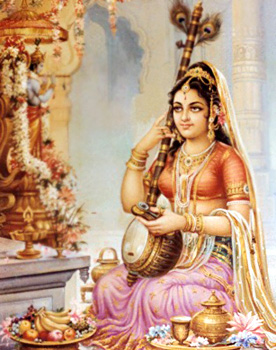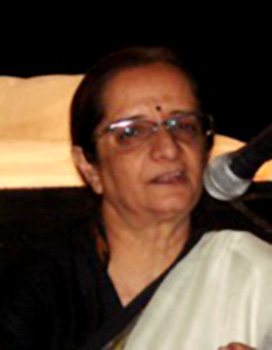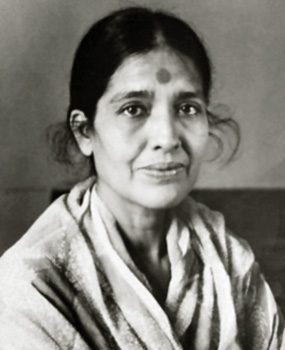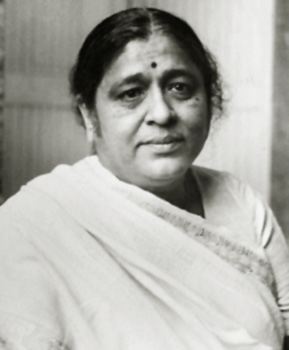 Women writers in Gujarati literature have been quite substantial as they have contributed immensely to the various literary genres- poetry, fiction, and, to a lesser extent, plays and criticism. The content and expression in women`s literary works has a typical feminine touch to it. This is probably due to the limited world of experience since they are usually homebound.
Women writers in Gujarati literature have been quite substantial as they have contributed immensely to the various literary genres- poetry, fiction, and, to a lesser extent, plays and criticism. The content and expression in women`s literary works has a typical feminine touch to it. This is probably due to the limited world of experience since they are usually homebound.
Women Poets
Among the first ever Gujarati woman poets was Meera Bai, unequaled in poetic excellence and popularity over the ages. She was followed by some devotional poets who, within the confines of their social existence, tried to spontaneously express themselves. There were some women poets of the nineteenth century whose works reflected the spirit of the age of social reform that prevailed after the coming of the British. Among them was Narmad`s disciple Savitagauri Pandya (1850-1925). Some Parsi and Christian poets like Alibai Palankat and Bai Astor, respectively, also joined their voices. Diwaliben Nathalal wrote an 18-page poem about injustices faced by women. Deepakba Desai (1881-1955) wrote some khandakavyas, and Munshi`s mother, Tapigauri, narrated her lifelong experiences in Anubhav Tarang and also wrote devotional songs. Sumatiben Mehta (1890-1911) conveyed her anguish during prolonged illness in Hridayjharnan (1912).
The emergence of new Gujarati poetry emerged due to a combination of various factors- concern for the downtrodden, the spirit of nationalism, and the spread of women`s education. All these sentiments and issues were seen conveyed in the women`s poetry in the Gandhian era. Thus the works of this nature include Jyotsna Shukla`s (1892-1976) poetry collections Akashnan Phool (1941), Azadinan Geeto (94-7), and others. But a didactic approach marred the aesthetic quality of her poems. Her contemporary Jaimangauri Pathakji (1901-84) showed a gentle quality and realistic and emotional touch in her collections like Tejacchaya and Sonalan, She also wrote sonnets and khandakavyas and attempted verse-dialogues. Poets like Pushpa Vakil (1908-85) wrote few but sensitive poems.
 In the period following Independence, women`s poetry took a new direction, even though some women poets stuck to the conventional type with a somewhat changed diction. Chaitanya Divatia (1919) published her khandakavyas, sonnets, and other works in Nivapanjali. Anniben Saraiya (1917-83), essentially a children`s poet, published 17 poetry collections, like Noopur (1958), Sonalnun Swapna (1979), and Culbanki (1982). Her poetry, on the whole, is of moderate quality, with conventional devotion to Lord Krishna.
In the period following Independence, women`s poetry took a new direction, even though some women poets stuck to the conventional type with a somewhat changed diction. Chaitanya Divatia (1919) published her khandakavyas, sonnets, and other works in Nivapanjali. Anniben Saraiya (1917-83), essentially a children`s poet, published 17 poetry collections, like Noopur (1958), Sonalnun Swapna (1979), and Culbanki (1982). Her poetry, on the whole, is of moderate quality, with conventional devotion to Lord Krishna.
A major woman poet of the modern era in literature is Heeraben Pathak. With only one collection, Paraloke Patra (1976), addressed to her deceased husband, Ramnarayan Pathak, she is ranked among the leading Gujarati poets. In this work, she has objectively narrated the intimate experiences of her married life, which was also a literary companionship. Heeraben is also one of the women to have written highly appreciated critical works, like Apanun Vivechansahita and Kavyabhavan. Gita Parkeh was another major literary poet of the time. Her collections Purvi (1966) and Bhinash (1979) give full expression to married existence and sentiments of love and philosophical thought. Her strong point is the depiction of nature, and she attempted almost all poetic forms.
In the later years, many women poets have come out of the proverbially enclosed feminine emotional world. Among them is Jaya Mehta (1929), with her collections like Venetian Blind (1978) and Akashman Tarao Chup Chhe (1985), which show her concern for the human predicament. Guided more by social awareness and logic than by emotion, she often contemplates life and death without making her poetry heavy with philosophical content. She describes her creative process as a desperate attempt to discover a healthy expression. In the works of Panna Nayak (Philadelphia, 1980 and Nisbat, 1988) is seen an attempt to arrive at a meeting point of Indian and American cultures with a modern sensitivity. She pointedly brings out the loneliness of modern people. Panna has effectively used a non-metrical style of poetry, in which she has expressed the anguish of her unfulfilled motherhood, along with the anguish of contemporary life, for she is always conscious of being a woman. One of the most experimental modern poets is Saroop Dhruv (1948). Her poems reflect her anguish at the disharmonies in the world situation.
Women Prose Writers
 Women started writing prose in the early years of the twentieth century. The humorous articles of Vidyagauri Nilkanth (1896-1958), wife of Ramanbhai Nilkant, were included in his Hasyamandir. She also wrote articles pertaining to women, collected in Grihadeepika (1931) and elsewhere, and a biography of Dhondo Keshav Karve. She was an early woman prose writer to have developed a refined style. Her contemporary Sharda Mehta (1882-1970) wrote a biography of Florence Nightingale and her autobiography, Jivansamharanan (1938), regarded as her most significant work. It was around the same time that Hansa Mehta a prominent member of the All-India Women`s Conference and educationist, entered the field as a competent translator with the Gujarati versions of eight cantos of the Sanskrit Ramayana, Shakespeare`s play Merchant of Venice, plays of Moliere, and Swift`s Gulliver`s Travels. She also wrote a couple of original plays.
Women started writing prose in the early years of the twentieth century. The humorous articles of Vidyagauri Nilkanth (1896-1958), wife of Ramanbhai Nilkant, were included in his Hasyamandir. She also wrote articles pertaining to women, collected in Grihadeepika (1931) and elsewhere, and a biography of Dhondo Keshav Karve. She was an early woman prose writer to have developed a refined style. Her contemporary Sharda Mehta (1882-1970) wrote a biography of Florence Nightingale and her autobiography, Jivansamharanan (1938), regarded as her most significant work. It was around the same time that Hansa Mehta a prominent member of the All-India Women`s Conference and educationist, entered the field as a competent translator with the Gujarati versions of eight cantos of the Sanskrit Ramayana, Shakespeare`s play Merchant of Venice, plays of Moliere, and Swift`s Gulliver`s Travels. She also wrote a couple of original plays.
An eminent prose writer of the following generation was K. M. Munshi`s wife, Lilavati Munshi (1899-1978). Rekhachitro one Bija Lekho (1925) instantly established her as a writer in her own right. After a lapse of five decades appeared her collections of short stories and one-act plays in Jivanani Vatetii (1977) and collection of articles in Sanchay (1975).
One of the important fiction writers of the post-Independence period is Kundanika Kapadia (1927), who won first prize for her very first short story, "Premnan Ansu," in the short story competition organized by the New York Herald Tribune, and, sometime afterward, her first collection appeared under the same title, followed by the collections Kagalni Hodi (1981) and Java Daishum Tamne (1983). She subsequently published her novels, Agan Pipasa (1972) and the Sahitya Akademi-winner, Saat Paglan Akashman (1984). Kundanika has a delicate style, often verging on the ornamental. She effectively expresses women`s innermost thoughts and feelings, pointing an accusing finger at male domination in family and society. Right from the beginning, she has written against injustices to women and their exploitation. But her anguish becomes anger in Saat Paglan Akashman, a totally feminist novel, translated into Hindi and English. Even in her expression of anger, there is her typical linguistic flourish.
 Another well-known prose writer of the time is Dhiruben Patel (1926), with her short story collections like Vishrambhkatha (1966). Her novels Vadvanal (1963), Vansno Ankur (1967), Andhali Gali, and others have been widely acclaimed. Dhiruben has also written plays, like Pahelun Inam (1957) and Namani Nagarvel (1961). She has written a full-length children`s play, children`s songs, and limericks. In her writings, Dhiruben reveals her understanding of the human mind and builds up the characters and situations, forming a natural pattern. She writes with ease and a sense of humor, encompassing in her works the life of men and women at various levels.
Another well-known prose writer of the time is Dhiruben Patel (1926), with her short story collections like Vishrambhkatha (1966). Her novels Vadvanal (1963), Vansno Ankur (1967), Andhali Gali, and others have been widely acclaimed. Dhiruben has also written plays, like Pahelun Inam (1957) and Namani Nagarvel (1961). She has written a full-length children`s play, children`s songs, and limericks. In her writings, Dhiruben reveals her understanding of the human mind and builds up the characters and situations, forming a natural pattern. She writes with ease and a sense of humor, encompassing in her works the life of men and women at various levels.
Saroj Pathak (1929-88) struck a new note as a fiction writer with her unusual choice of subjects. They mainly dealt with disharmony in married life. Her choice of subjects and the force of her expression makes her stand apart from other women writers. Saroj`s short stories collected in Ghata Zuk Aayi and Virat Tapakun (1966) have a tremendous power to hold one`s attention, as do her novels Nihshesh (1978) and Priya Punam (1980), reflecting conflicts and complexities in women`s lives.
The two sisters, Varsha Adalja and Ila Arab Mehta, have written fiction without the slightest trace of similarity. Varsha`s Pachhan Faratan (1979), Khari Padelo Tahuko (1988), Retpankhi (1985), and other novels deal mainly with middle-class life, with an emphasis on contemporary women. She is not a feminist writer but describes in her fiction women`s situation in the best artistic manner possible, with a fairly well-developed expression. Ila, on the other hand, has a wider canvas. Even the titles of her novels, like Shabne ne Naam Nathi Hotun, Ek Cigarette ane Dhoopsali, and Ane Mrityu suggest that her writing is not the usual feminine kind and that a great deal of reflections on life and death have gone into it. Her action-packed, gripping novels and short stories create quite an impact on the readers. There are many more fiction writers, like Vasuben Bhatt, Meenal Dikshit, Anjali Khandwala, and Himanshi Shelak, whose works have added to women`s creative writing in Gujarati.
Women playwrights
The only other woman playwright, apart from Dhiruben Patel, is Rambhaben Gandhi, who held the field for many years with her one-act plays like Aarati and Insaaf, about contemporary themes dealing with middle-class life in a lively manner, with a touch of humor and satire and easy flow of language.
Women`s contribution to critical writing is really meager. Susmita Medh and Tarulala Mehta are the only names that can be mentioned, apart from Heeraben Pathak, who have done critical writing.
Thus the contribution of women writers to the field of Gujarati literature has been rather immense.













